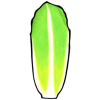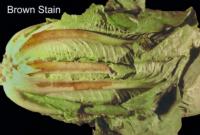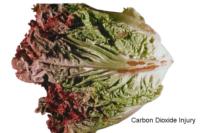Maturity and Quality
Romaine or cos lettuce is an elongated heading lettuce type. Maturity is based on the number of leaves and head development. A very loose or easily compressible head is immature and a very firm or hard head is overmature. Heads that are immature
After trimming outer leaves, the leaves should be a bright to dark green color (tinged with red in the red romaine cultivars) with the inner leaves of the head being yellow or light green. The bright to dark green of romaine leaves is indicative of higher vitamin A and vitamin C contents relative to iceberg lettuce types. Leaves should be crisp and turgid, and free from insects, decay or mechanical damage (U.S. Grade No. 1). Different romaine varieties may vary in sweetness and bitterness.
Postharvest Handling and Storage
0°C (32°F) is required to optimize the postharvest life of romaine lettuce. A shelf-life of around 21 days is expected at this temperature. At 5°C (41°F) a shelf-life of about 14 days can be expected as long as no ethylene is in the environment. Water spray-vacuum cooling or hydrocooling are often used for romaine lettuce, but forced-air cooling may also be used.
Freezing Injury. Freeze damage can occur in the field and cause separation of the epidermis from the leaf. This weakens the leaf and leads to bacterial decay during storage. Freeze damage can occur during storage if the lettuce is held at <-0.2°C (31.7°F). This appears as darkened translucent or water-soaked areas that will turn slimy and deteriorate rapidly after thawing.
Romaine lettuce heads have moderate respiration rates, but they are generally higher than rates for iceberg lettuce:
| Temperature | 5°C (41°F) | 10°C (50°F) | 15°C (59°F) | 20°C (68°F) |
| ml CO2/kg·hr | 9-12 | 15-20 | 19-25 | 30-38 |
To calculate heat production multiply mL CO2/kg·hr by 440 to get Btu/ton/day or by 122 to get kcal/metric ton/day.
Romaine lettuce is sensitive to ethylene. Ethylene damage appears as discolored spots on the midrib. These are generally larger and less defined than those found with ethylene-induced Russet spotting on iceberg lettuce (see physiological disorders). Varieties can vary significantly in their susceptibility to ethylene.
>95%
Ethylene production rates are very low:
Some benefit to shelf-life can be obtained with low O2 atmospheres (1-3%) at temperatures of 0-5°C (32-41°F). Low O2 atmospheres will reduce respiration rates and reduce the detrimental effects of ethylene. Intact heads are not generally benefited by atmospheres containing CO2 and injury may occur with >5% CO2 (see physiological disorders, brown stain). Cut Romaine lettuce, however, is commonly packaged in low O2 (<1%) and high CO2 (7-10%) atmospheres because these conditions control browning on the cut surfaces. On salad pieces, cut surface browning occurs more rapidly and more extensively than do symptoms of brown stain caused by CO2. Cut iceberg lettuce tolerates higher CO2 concentrations than cut romaine lettuce.
Temperature & Controlled Atmosphere Photos
Disorders
Several disorders can occur on romaine lettuce. Some very common and important disorders are the following.
Tipburn. A disorder caused in the field and is related to climactic conditions, variety selection and mineral nutrition. Leaves with tipburn are unsightly and the damaged leaf margins are weaker and susceptible to decay.
Ethylene injury. Due to exposure to low concentrations of ethylene gas which stimulates the production of phenolic compounds which in turn leads to brown pigments. Russet spots appear as dark brown spots especially on the midribs. Under severe conditions, russet spots are also found on the green leaf tissue and throughout the head. The disorder is strictly cosmetic but makes the lettuce unmarketable. Ethylene contamination may occur from propane fork lifts, transport in mixed loads, or storage with ethylene-generating fruits such as apples, pears, etc.
Brown Stain. The symptoms of this disorder on romaine lettuce heads are yellowish-reddish-brown large, depressed spots or stains. These are most noticeable on the midribs, and may darken and enlarge with time. Brown stain is caused by exposure to CO2-containing atmospheres, especially at concentrations above 5%. Visual symptoms of brown stain may occur less rapidly on Romaine than on iceberg lettuce.
Pink rib. A disorder associated with heads that are overmature. Higher than recommended storage temperatures can also lead to a increased incidence of pink rib. In this disorder, the midribs take on a generalized pinkish coloration. Ethylene exposure does not appear to affect pink rib and low O2 atmospheres do not control it.
Breakage of the midribs often occurs during field packing, especially on overmature romaine heads, and results in unsightly browning and increased susceptibility to decay. Product harvested early in the morning, when pulp temperatures are lower, is more susceptible to midrib cracking and breakage.
Bacterial soft-rots are caused by numerous bacteria species and result in a slimy breakdown of the infected tissue. Soft-rots may follow fungal infections. Trimming outer leaves, rapid cooling and low temperature storage reduce development of bacterial soft-rots.
Fungal pathogens may also lead to a watery breakdown of lettuce (watery soft-rot caused by Sclerotinia or gray mold rot caused by Botrytis cinerea) but are distinguished from bacterial soft-rots by the development of black and gray spores. Trimming and low temperatures also reduce the severity of these rots.
Special Considerations
Cut or broken midribs of Romaine lettuce may discolor more rapidly than cut pieces of iceberg lettuce. This is probably due to the higher content of phenolic compounds found in romaine leaves compared to iceberg leaves. Romaine varieties can vary greatly in the rate and severity of discoloration of cut pieces.





